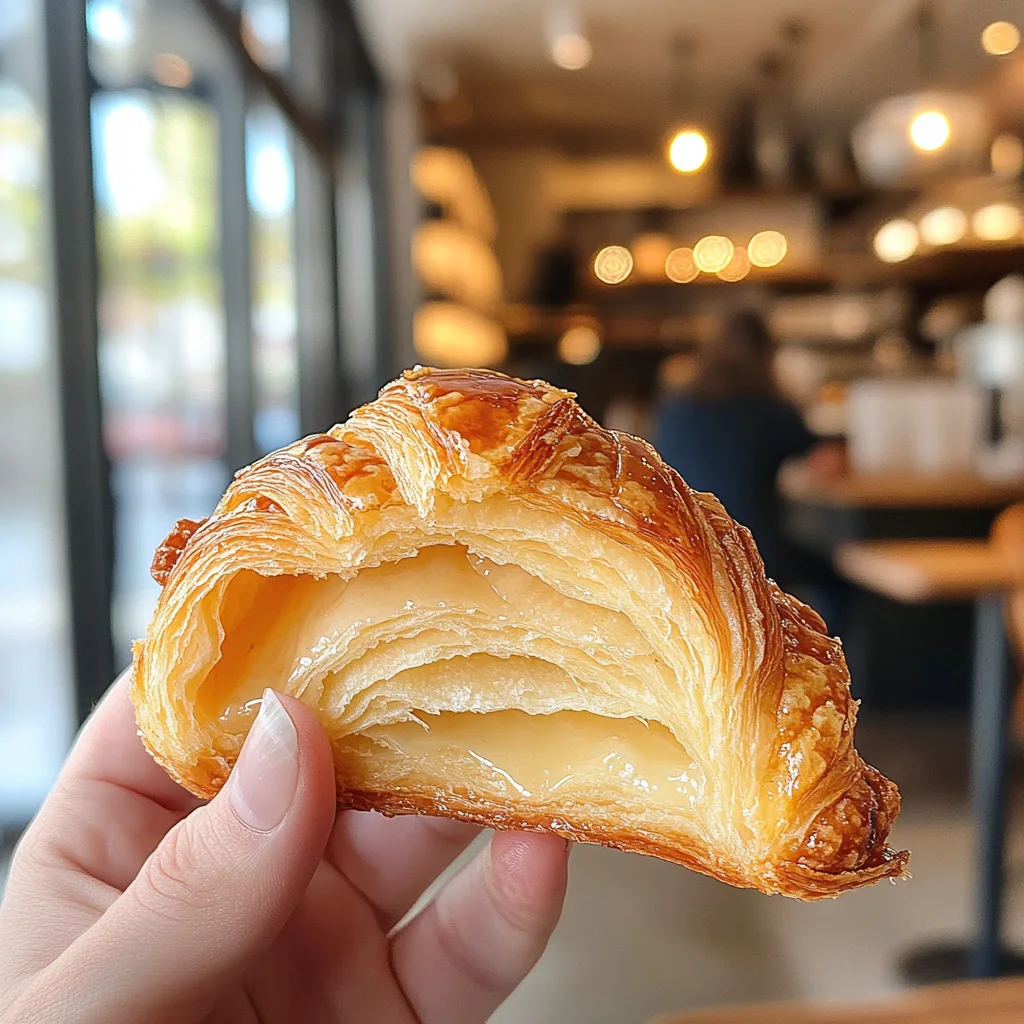
Let’s be honest, who can resist the sight of a perfectly glazed croissant? That glistening surface, the promise of flaky layers underneath, and that sweet, satisfying crunch – it’s pure magic! But what is it that truly makes this pastry so special? It’s more than just breakfast; it’s an experience, a moment of pure indulgence. In this deep dive, we’re going to explore everything that makes the glazed croissant the star that it is – from its humble beginnings to its global variations and, yes, even how to troubleshoot some common baking mishaps. Get ready to embark on a delicious journey into the world of the glazed croissant! French pastry techniques!
What Makes the Glazed Croissant So Special and Irresistible

Let’s face it; there are many pastries out there vying for our attention, but few hold the same charm as the glazed croissant. It’s a delightful marriage of textures and flavors that truly sings. It’s not just about slathering a basic sugar glaze over any old croissant; it’s about the perfect synergy between the two. So, what’s the secret behind its irresistible appeal?
Print
The Magic of the Glazed Croissant
- Total Time: 3-5 hours
- Yield: 6-12 croissants
- Diet: Vegetarian
Description
- This article explores the world of glazed croissants, delving into what makes them so irresistible, from the flaky base to the sweet glaze. We examine different types and variations found around the world, address common baking problems and provide solutions, and discuss how best to enjoy this delectable treat.
Ingredients
- For the Croissant: Flour, butter, yeast, water, salt, sugar.
- For the Glaze: Powdered sugar, water, flavoring (such as vanilla extract or lemon juice).
Instructions
1. Prepare the croissant dough (laminated dough technique).
2. Shape the dough into croissants.
3. Bake the croissants until golden brown.
4. Allow the croissants to cool completely.
5. Prepare the glaze by combining powdered sugar, water, and any desired flavoring.
6. Warm the glaze slightly.
7. Dip or brush the glaze over the cooled croissants.
8. Allow the glaze to set.
Notes
- The consistency of the glaze is key—it should be thick enough to coat but not too runny. Ensure the croissants are completely cool before glazing to avoid sogginess. Experiment with different flavorings for the glaze to suit your preferences.
- Prep Time: 1-2 hours
- Cook Time: 20-25 minutes
- Category: Bakery, Pastry
- Method: Baking
- Cuisine: French
Nutrition
- Serving Size: 1 Average Glazed Croissant
- Calories: 250-350 calories
- Sugar: 15-25 grams
- Sodium: 150-250 mg
- Fat: 12-20 grams
- Carbohydrates: 30-40 grams
- Fiber: 1-2 grams
- Protein: 5-7 grams
Keywords: • glazed croissant, croissant, pastry, baking, French pastry, glaze, viennoiserie, breakfast, dessert, sweet, sugar, bakery
The Flaky Foundation: Perfecting the Croissant Base for a Glazed Delight
The base of any good glazed croissant is, of course, the croissant itself. It’s a masterpiece of French baking, made with laminated dough—layer upon layer of dough and butter, carefully folded and rolled. When baked, those layers puff up, creating that airy, flaky interior that we all crave. This painstaking process is the first step to a truly spectacular glazed croissant. If the croissant base isn’t top-notch, the glaze will only mask, not enhance. Think of it like building a house – you need a solid foundation first! If your croissant is dense or doughy, no amount of glaze will fix it. A good croissant should be light, airy, and buttery with each bite. When we talk about the perfect glazed croissant, it begins here.
The Magic of Glaze: Elevating the Glazed Croissant Beyond Sugar
While the croissant is the foundation, the glaze is definitely the star that adds that extra sparkle. But let’s be clear: it’s not just about a simple dusting of sugar. A good glaze is a precisely crafted syrup that creates a smooth, glassy finish. It provides the perfect level of sweetness to compliment the buttery richness of the croissant. A good glaze should be thick enough to coat evenly, yet thin enough not to be overly sticky or heavy. It also needs to hold its shine and crispness, even after cooling down. The glaze isn’t just an afterthought; it’s a carefully considered component that elevates the entire experience. It’s the element that takes the croissant from good to absolutely amazing. Some glazes might incorporate other flavors – a hint of vanilla, a touch of citrus, or even a delicate floral note. This is where bakers really showcase their creativity and expertise.
“The real magic of a glazed croissant isn’t just in its taste; it’s in the way it makes you feel. That first bite, that sugary crunch followed by the soft flaky interior – it’s pure bliss.”
A Global Journey: Exploring Variations of the Glazed Croissant Worldwide
The beauty of the glazed croissant is that while its roots are firmly planted in French tradition, it’s a pastry that has travelled the globe, adapting and evolving with local tastes and preferences. This means you can find a delightful array of variations, each with its own unique charm. Let’s take a little culinary tour, shall we?
American Twists: Bold Flavors and Creative Toppings
Across the Atlantic, the glazed croissant has taken on a more adventurous persona. American bakeries often experiment with bold flavors, incorporating ingredients like maple syrup, cinnamon, chocolate, and even nuts into the glaze. You might find croissants dipped in vibrant colored glazes, decorated with sprinkles, or filled with various creams and jams before being glazed. The American approach is all about indulgence and creativity, pushing the boundaries of what a glazed croissant can be. It’s not uncommon to see over-the-top creations that are as much a feast for the eyes as they are for the palate. This willingness to experiment has led to some truly unique and exciting versions of the glazed croissant. It reflects the American spirit of innovation and the desire to create something both delicious and visually appealing.
Beyond the Basics: Exploring Unique Glazed Croissant Inspirations
Beyond France and America, you can find glazed croissant variations that draw from diverse culinary traditions. Imagine a croissant glazed with matcha in Japan, offering a unique earthy sweetness, or a version in South America where the glaze might be flavored with dulce de leche for a rich caramel note. In some places, you might find croissants dipped in a rose water-infused glaze, giving it a delicate floral aroma, or even savory variations with a honey and herb glaze. These examples highlight how the basic concept of a glazed croissant can be adapted to suit local tastes and preferences. It’s this adaptability that makes it such a globally loved pastry, with each region adding its own special touch to this iconic treat. It’s exciting to see how something so simple can be transformed by cultural influences, creating an incredible spectrum of flavors.
Common Problems and Solutions When Making Glazed Croissants
Okay, so we’ve talked about the magic and beauty of glazed croissants, but let’s face it: making them at home can sometimes be a challenge. From soggy bases to glazes that just won’t stick, there are a few common pitfalls that can get in the way of achieving that perfect pastry. But don’t worry! I’m here to walk you through some of the common problems and, more importantly, how to fix them.
Problem 1: Soggy Croissants After Glazing
One of the most frustrating issues when making glazed croissants is when that glorious, crisp pastry turns soggy after it’s been glazed. This usually happens when the glaze is too thin or applied while the croissants are still warm. The moisture from the glaze soaks into the delicate layers, ruining the texture and making the croissant feel heavy and wet instead of light and airy. It’s like a beautiful piece of art getting ruined by the rain. Not what we want at all!
Solution: The Perfect Glaze Consistency and Application
The key to preventing soggy croissants is to focus on the consistency of the glaze and the timing of your application. The glaze should be thick enough to coat the pastry evenly but not so runny that it soaks in. Think of it like a thick syrup, coating rather than seeping. Also, make sure your croissants are completely cool before glazing. This allows the layers to firm up, preventing the glaze from penetrating too deeply. If the glaze is too thin, you can add a bit more powdered sugar or cornstarch to thicken it. Also, consider using a wire rack to allow the excess glaze to drip off. Proper glaze consistency and letting your croissants cool are the essential steps to avoiding this common problem and keeping those layers perfectly crisp.
Problem 2: Glaze That Doesn’t Stick
Another common frustration is when your glaze refuses to adhere to the croissant. It slides right off, leaving you with a patchy, uneven finish. This can be caused by several factors including the glaze being too thin, the croissants being too oily, or the temperature being off. It’s like trying to paint on a surface that just won’t hold the color – very annoying! You want that beautiful, even coating, and a glaze that doesn’t stick simply won’t cut it.
Solution: Achieving the Right Temperature and Surface Prep
To get your glaze to stick properly, temperature is key. The glaze should be warm, not hot, and the croissants should be completely cooled. A warm glaze will be more viscous and adhere better to the cold croissant surface. If the glaze is too thin, a quick fix is to add a bit more powdered sugar or cornstarch. Also, ensuring your croissants aren’t excessively oily can make a huge difference. If they’re too greasy, they will repel the glaze. Consider letting your croissants cool on a wire rack to allow any excess grease to drip off. Sometimes, lightly brushing the surface with a very thin layer of apricot jam can act as a “glue” for the glaze, helping it adhere more effectively. By paying attention to these details, you can achieve that perfectly coated glazed croissant every time.
Problem 3: Glaze That’s Too Sweet or Bland
And lastly, let’s talk about the taste. A glaze that’s either overwhelmingly sweet or disappointingly bland can completely throw off the balance of your glazed croissant. A glaze that’s too sweet masks the delicate buttery flavor of the croissant, making it cloying and unpleasant. On the other hand, a bland glaze is just, well, boring and won’t contribute anything to the overall experience. Getting that “just right” level of sweetness is vital.
Solution: Flavor Balancing and Experimentation
The key here is to find the perfect balance between sweetness and flavor. The standard powdered sugar and water glaze is a good starting point, but you can easily adjust the ratios and add other ingredients to tweak the flavor. Consider adding a pinch of salt to counteract excessive sweetness, or a squeeze of lemon juice for brightness. Infusing the glaze with vanilla extract, citrus zest, or even a hint of spice can also add depth and complexity. Don’t be afraid to experiment with different flavorings to create a glaze that perfectly complements the buttery goodness of your croissant. The beauty of baking lies in the freedom to adjust and create something that truly suits your taste preferences.
How to Enjoy Your Glazed Croissant to the Fullest

Now that we’ve tackled the potential pitfalls of making a glazed croissant, let’s talk about the best ways to enjoy this delicious treat! It’s more than just eating; it’s about savoring the experience.
Pairing Perfection: Complementary Drinks and Accompaniments
A glazed croissant is delightful on its own, but it can be elevated even further with the right pairings. A classic choice is a cup of freshly brewed coffee or a rich latte. The bitterness of the coffee cuts through the sweetness of the glaze, creating a harmonious balance. Alternatively, a glass of cold milk or a refreshing orange juice are also wonderful pairings. For those who want to indulge a little more, consider serving your glazed croissant with a scoop of vanilla ice cream or a dollop of whipped cream. The contrast between the warm pastry and the cold dessert creates a delightful textural and temperature sensation.
The Art of Eating: Savoring Every Layer
Don’t just gobble it down! Take your time and truly appreciate the craftsmanship that went into creating this delectable treat. Observe the glistening glaze, the flaky layers, and the airy interior. Take a bite and allow the flavors to unfold on your palate – the sweet crunch of the glaze, the buttery richness of the pastry. Let the different textures play in your mouth. Take your time. This is not just food; it’s an experience. And experiences like this should be savored and remembered.
Glazed Croissants: A Treat for Any Time of Day

One of the great things about glazed croissants is their versatility. They’re not just for breakfast; they can be enjoyed at any time of day.
Breakfast Bliss: Start Your Day with a Sweet Indulgence
There’s no better way to start the day than with a fresh, flaky glazed croissant and a cup of coffee. It’s the perfect pick-me-up and will set a happy tone for the day ahead. Whether enjoyed in a quiet moment alone or shared with loved ones, a glazed croissant is a delightful addition to any morning.
Afternoon Delight: A Perfect Midday Pick-Me-Up
When you need a little boost in the middle of the afternoon, a glazed croissant is the ideal treat. Its sweetness provides a quick burst of energy, and its deliciousness is sure to brighten any day. It’s a great way to take a break and indulge in something truly enjoyable.
Dessert Dream: The Glazed Croissant as an Elegant Sweet Finale
And finally, let’s not forget that a glazed croissant can be a sophisticated and elegant dessert. It pairs beautifully with a glass of dessert wine or a cup of herbal tea. Whether you’re hosting a dinner party or just enjoying a quiet evening at home, a glazed croissant is the perfect sweet ending to any occasion.
“The best moments in life are often the simplest – like enjoying a warm, perfectly glazed croissant.”
Where to Find the Best Glazed Croissants
If you’re not up for making your own, here are some places where you can find excellent glazed croissants:
Local Bakeries: Supporting Artisanal Craftsmanship
Your local bakery is often the best place to find truly exceptional glazed croissants. Bakers take pride in their craft and use high-quality ingredients to create pastries that are as delicious as they are beautiful. By supporting your local bakery, you’re not only treating yourself but also the community.
Cafes and Patisseries: A Haven for Sweet Treats
Cafes and patisseries often offer a wide variety of pastries, including expertly made glazed croissants. It’s a perfect spot to sit, relax, and indulge in a delicious treat with a cup of coffee or tea. The ambiance is often as much a part of the experience as the food itself.
Making Your Own: The Joy of Home-Baked Glazed Croissants
Of course, the most rewarding experience can be baking your own glazed croissants at home. It might take a little practice, but the sense of accomplishment when you pull a batch of golden, glazed croissants out of the oven is truly unmatched. And the aroma alone is worth the effort!
Okay, here’s a paragraph with an H3 heading, incorporating the provided internal links, that would fit well within the context of your article about glazed croissants:
Beyond the Glazed Croissant: Exploring Other Delicious Delights
While the glazed croissant holds a special place in our hearts, the world of culinary treats is vast and exciting. If you’re looking to expand your baking or snacking horizons, there are numerous other delicious paths to explore. For a fun and flavorful savory option, consider trying your hand at making mini croissant sandwiches. Or, for a completely different sweet experience, dive into the world of gooey perfection with a brookie recipe. And for a salty-sweet indulgence, why not try some butter toffee pretzels? If you prefer something spicy, learn about what are the positives about hot fries? And for a more substantial meal, explore the deliciousness of a boulders enchilada recipe. So, while savoring your glazed croissant is a wonderful experience, don’t be afraid to venture out and try new flavors and textures from around the culinary landscape.
FAQs About Glazed Croissants
Q1: What exactly is the glaze on glazed croissants?
A: The glaze on a glazed croissant is typically a simple syrup made from sugar and water, often with a touch of flavoring like vanilla extract, lemon juice, or a pinch of salt. The syrup is cooked to the right consistency to create a smooth, glossy coating that adds a layer of sweetness and a delightful crunch. It’s this glaze that gives the croissant that irresistible shine and helps it retain its deliciousness.
Q2: Will Publix or other grocery stores glaze a croissant for me?
A: While some larger bakeries within grocery chains may occasionally offer glazed croissants, they don’t typically provide an option to glaze a croissant on request. Publix, for instance, usually sells pre-glazed croissants if they are offered. Your best bet is to purchase a pre-made glazed croissant or try a local bakery. Alternatively, it’s quite easy to glaze croissants at home with a basic sugar syrup.
Q3: What are the two main types of croissants I might find?
A: You’ll generally find two main types of croissants: the classic, curved croissant ordinaire made with butter, and the straight croissant au beurre , which often has a different shape but similar base ingredients. The croissant ordinaire is usually the standard type, while the au beurre is typically richer with more butter. When it comes to glazed croissants, both types can be used, it really comes down to personal preference.
Q4: What makes a croissant shiny?
A: The shininess of a croissant usually comes from two things. The first is the butter content of the dough, which creates a slight sheen when baked. Secondly, if the croissant is glazed, the glaze is what creates that signature glossy shine. A well-made sugar glaze is key to making that lovely shiny finish on a glazed croissant. The glaze’s smooth surface reflects light beautifully, giving it a polished, attractive look.
Q5: How do I prevent my glazed croissant from getting soggy?
A: The key to preventing soggy glazed croissants is to ensure that your croissants are completely cooled before glazing them, and that the glaze has the right consistency. A glaze that’s too thin or applied to a warm croissant will soak into the layers, making them soggy. Let the croissants cool thoroughly on a wire rack, and use a thicker glaze, to avoid this issue. Make sure to use a wire rack after glazing as well so that excess glaze can drip down and not pool up.
Conclusion: The Enduring Appeal of the Glazed Croissant
From its flaky layers to its sweet, glistening glaze, the glazed croissant is a pastry that holds a special place in the hearts (and stomachs!) of many. It’s a treat that is both simple and sophisticated, adaptable and always delicious. Whether you enjoy it as a quick breakfast, an afternoon pick-me-up, or an elegant dessert, the glazed croissant is a pastry that truly knows how to delight. So the next time you encounter one of these beauties, take a moment to appreciate all that makes it so special.
